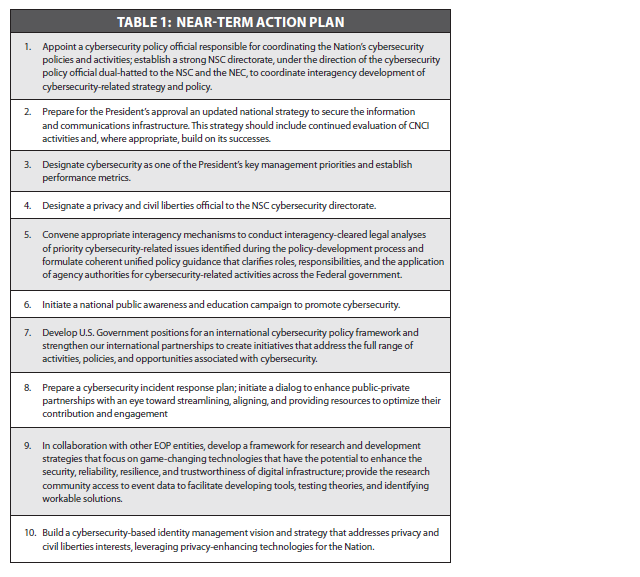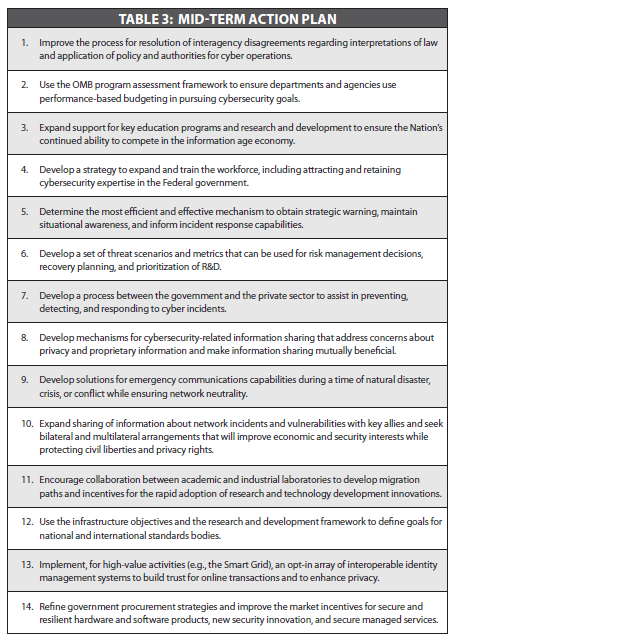Cybersecurity: Difference between revisions
| Line 32: | Line 32: | ||
====A. SCADA Systems==== | ====A. SCADA Systems==== | ||
[http://en.wikipedia.org/wiki/SCADA SCADA] systems (SCADA stands for supervisory control and data acquisition) are computer systems that oversee industrial computer systems. Generally the term is used to refer to governmental systems such as the computer systems that regulate dams, traffic lights, and other components of civilian infrastructure. One of the most public issues has been concern that a hacker could shut down public power grids or that terrorists could utilize the SCADA systems to destroy infrastructure. See [[SCADA | [http://en.wikipedia.org/wiki/SCADA SCADA] systems (SCADA stands for supervisory control and data acquisition) are computer systems that oversee industrial computer systems. Generally the term is used to refer to governmental systems such as the computer systems that regulate dams, traffic lights, and other components of civilian infrastructure. One of the most public issues has been concern that a hacker could shut down public power grids or that terrorists could utilize the SCADA systems to destroy infrastructure. See this recommendation [http://www.oe.netl.doe.gov/docs/prepare/21stepsbooklet.pdf "21 Steps to Improve SCADA security"] for how to address these threats. See a report on a [http://online.wsj.com/article/SB123914805204099085.html SCADA hijack into the US electricity grid (2009)] or this report on [http://www.computerworld.com/s/article/108735/Utility_hack_led_to_security_overhaul Australian sewage and water system hack] for examples of the type of vulnerabilities we face. Also consider more extreme examples: could a hacker access a [http://tech.commongate.com/post/Hacker_Hits_Nuclear_Plant nuclear power plant]? | ||
====B. Servers==== | ====B. Servers==== | ||
Revision as of 04:36, 2 December 2009
SCOPE OF THE PROBLEM
According to the U.S. federal government, threats to cyberspace pose one of the most serious economic and national security challenges of the 21st Century.[1] An increasing number of state and non-state actors are now capable of targeting U.S. citizens, financial institutions, critical infrastructure, and government organizations. The Commission on Cybersecurity, established to advice President Obama in his new administration, stated the challenge: "America's failure to protect cyberspace is one of the most urgent security problems facing the new administration."[2] In fact, the intelligence community assessment is that already a number of nations have the capability to conduct crippling attacks against the U.S.[1]
One reason cybersecurity poses such a security threat is that the term 'cybersecurity' applies to almost everything. The White House Cyberspace Policy Review that analyzes the current cybersecurity threat defines the term broadly:
Cybersecurity policy as used in this document includes strategy, policy, and standards regarding the security of and operations in cyberspace, and encompasses the full range of threat reduction, vulnerability reduction, deterrence, international engagement, incident response, resiliency, and recovery policies and activities, including computer network operations, information assurance, law enforcement, diplomacy, military, and intelligence missions as they relate to the security and stability of the global information and communications infrastructure. The scope does not include other information and communications policy unrelated to national security or securing the infrastructure.[3]
Summarizing, the Policy Review notes that âCyberspace touches practically everything and everyone.â[3] Given this definition, it is no wonder that cybersecurity is perceived as an almost insurmountable problem. In order to begin approaching solutions, therefore, we will first begin by breaking down our understanding of what cybersecurity means.
ASSESSING VULNERABILITY
The internet is a large-scale decentralized network of generative computers. (For an introduction to how the internet works, read the first two pages of BGP Attack.) This network is vulnerable to attack at several different key points, each with a different result and security concern. The taxonomy below breaks down the security issues according to what part of the network is under attack. Real life examples of attacks are then provided to illustrate the danger of attacks, and the application of this knowledge to cyberwarfare is then considered.
If you need background on how the internet works and is related, watch JZ's background video about internet and law.
In order to help us understand cybersecurity, we can break down our analysis of vulnerable points in cyberspace by separating out the point of attack.
I. Vulnerability in the Network Itself
This vulnerability considers attacks upon the network itself. A clever hacker could shut down the internet itself in an extreme case, or more conservatively can re-route the internet to prevent users from getting where they need to go.
The internet is a large-scale decentralized network. A packet sent from one computer to another may cross multiple networking administrative domains (called Autonomous Systems [AS]). Internet routing includes two different systems: an intra-domain routing system and an inter-domain routing system. AS routes traffic within its infrastructure any way it likes, but all of the AS's coordinate inter-domain routing by running a Border Gateway Protocol (BGP) on routers that connect the AS's. The BGP computes routes between every AS and every IP address.[4]
To attack the network itself, however, it is then possible to cause a disconnect in the BGP-AS connection. The best example of an attack on internet as a network is such a BGP attack: this kind of attack gained publicity through the recent incident in which Pakistan accidentally took down YouTube. See this case study on Pakistan & Youtube and this comment on the threat of BGP hijacking for more details.
II. Vulnerability in the Network Endpoints
The internet as a network joins together numerous end point computers. These endpoints are all vulnerable targets in and of themselves, though the nature of the end point changes some of the ramifications of its attack.
A. SCADA Systems
SCADA systems (SCADA stands for supervisory control and data acquisition) are computer systems that oversee industrial computer systems. Generally the term is used to refer to governmental systems such as the computer systems that regulate dams, traffic lights, and other components of civilian infrastructure. One of the most public issues has been concern that a hacker could shut down public power grids or that terrorists could utilize the SCADA systems to destroy infrastructure. See this recommendation "21 Steps to Improve SCADA security" for how to address these threats. See a report on a SCADA hijack into the US electricity grid (2009) or this report on Australian sewage and water system hack for examples of the type of vulnerabilities we face. Also consider more extreme examples: could a hacker access a nuclear power plant?
B. Servers
Rather than targeting individual computers, attackers can target servers and providers. Once a server is infected, it propagates the infection and compromises other internal computers and sensitive servers incorrectly thought to be protected from unauthorized access by external entities. This infection can also result in servers being shut down by regulators in order to prevent the spread of infection, thereby effectively stopping business at that site. This can have significant implications depending on the nature of the site. See a more in-depth discussion of this at Chuckroast Server Attack Example.
C. Personal Computers
The term personal computers is meant broadly to apply to individual computers rather than larger servers or systems. However, the use of these computers - whether for government application, industrial business, or private personal use - has a significant impact on the nature of the security concern. One of the vulnerabilities that all types of personal computers share, however, is that all the computers are generative, having the power to create. This very generativity adds to the potential vulnerability of the computers.
In his book, The Future of the Internet and How To Stop It (Chapter 3) on generativity and cybersecurity, Zittrain describes the Morris Worm Attack - the first virus attack (1988) and how the changing nature of the internet made that attack possible:
[T]he Morris worm really was not perceived as a network problem, thanks to the intentional conceptual separation of network and endpoint. The Morris worm used the network to spread but did not attack it beyond slowing it down as the worm multiplied and continued to transmit itself. The wormâs targets were the networkâs endpoints: the computers attached to it. The modularity that inspired the Internetâs design meant that computer programming enthusiasts could write software for computers without having to know anything about the network that would carry the resulting data, while network geeks could devise new protocols with a willful ignorance of what programs would run on the devices hooked up to it, and what data would result from them. Such ignorance may have led those overseeing network protocols and operation unduly to believe that the worm was not something they could have prevented, since it was not thought to be within their design responsibility.
...
Even without...flaws, the machines were intentionally designed to be operated at a distance, and to receive and run software sent from a distance. They were powered on and attached to the network continuously, even when not in active use by their owners. Moreover, many administrators of these machines were lazy about installing available fixes to known software vulnerabilities, and often utterly predictable in choosing passwords to protect entry to their computer accounts. Since the endpoint computers infected by the worm were run and managed by disparate groups who answered to no single authority for their use, there was no way to secure them all against attack.
The computers could not be secured because each computer could incorporate the code, use it and further distribute it.
Whether through a sneaky vector like the one Morris used, or through the front door, when a trusting user elects to install something that looks interesting without fully understanding it, opportunities for accidents and mischief abound. A hobbyist computer that crashes might be a curiosity, but when a home or office PC with yearsâ worth of vital correspondence and papers is compromised, it can be a crisis. And when thousands or millions of individual, business, research, and government computers are subject to attack, we may find ourselves faced with a fundamentally new and harrowing scenario. As the unsustainable nature of the current state of affairs becomes more apparent, we are left with a dilemma that cannot be ignored. How do we preserve the extraordinary benefits of generativity, while addressing the growing vulnerabilities that are innate to it?
ref = http://bostonreview.net/BR33.2/zittrain.php
http://www.temple.edu/lawschool/dpost/Zittrain.pdf
http://www.emergentchaos.com/archives/2008/04/generativity_emergent_cha.html
1. Government Computers
Government Computer Attack Examples
2. Industrial Computers
Industrial / Financial Computer Attack Examples
3. Private Individual Computers
Application in Cyberwarfare
NEXT STEPS
White House Action Plans
REFERENCES
- ↑ Jump up to: 1.0 1.1 [1]Dennis Blair, Director of National Intelligence, Annual Threat Assessment of the Intelligence Services Committee, Statement for the Record, March 10, 2009, at 39.
- ↑ [2]CSIS Commission on Cybersecurity, Security Cyberspace for the 44th Presidency, Dec. 2008.
- ↑ Jump up to: 3.0 3.1 [3] White House Cyberspace Policy Review, p2 (March, 2009).
- ↑ [4]J. Kim et al., A BGP Attack Against Traffic Engineering, PROCEEDINGS OF THE 2004 WINTER SIMULATION CONFERENCE 318 (2004).
- ↑ Jump up to: 5.0 5.1 [5] White House Cyberspace Policy Review, p37-38 (March, 2009).

